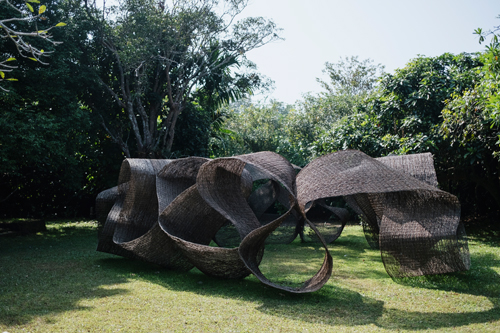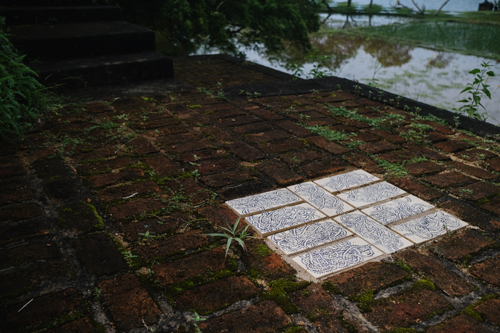Their gift to Bawa

Kitul ami: Kengo Kuma’s installation
For 18 months – through rain and shine; under appraising gazes and the primordial silence when only the gardeners and the squirrels, the polecats and the parrots were there to admire and puzzle over these works of art in conversation with the lake and its reaches, the lotus pond with bamboo groves, the cinnamon hill and the shadowed ‘Sandella’ pavilion – The Gift project had presented the Lunuganga estate with five transitory pieces; five works of art to grace the estate like maverick self-portraits.
The Geoffrey Bawa Trust brought five artists to respond to the ‘gift’ that architect Bawa’s serene country estate has always been, having creatively nourished the likes of writer Michael Ondaatje and artist Laki Senanayake when working on his fantastic sculpted beasts.
Each of the five chosen artists’ works was their gift back – to Bawa and to Lunuganga, for the deep inspiration always generously given.
As The Gift project comes to a close, the Trust hosted a virtual conversation where the five artists talked about their work, inspiration, exchanging ‘gifts’ and creating art in troubled times.
Moderator Suhanya Raffel led the discussion with veteran architect Kengo Kuma, as the starting point given that his Japan National Stadium in Tokyo was the site of the recently concluded Olympics.
Though designed at a time when COVID-19 would not have been remotely foreseen, the stadium was so ‘human’ that the fact that it was empty of audiences went almost unnoticed. One of his secrets was to create a mosaic of colours because ‘having one colour alone is not human’.
Giving his buildings intimacy and a ‘natural’ feel were lessons he learnt from Bawa’s works, Kuma confessed, adding that the installation he did by the lake at Lunuganga, Kitul-ami, was rather special given its material, kitul, was local and natural. It is a lesson that people are only learning now, after the pandemic, that concrete and steel are unhealthy and lead to stress; that natural material leads to a better relationship between humans and nature.

Embedded decorative tiles: Thenuwara’s gift
Dominic Sansoni spoke about his own installation which included intimate, casual portraits of the invisible hands behind the garden, the people who maintain Lunuganga as Bawa dreamed it, and the fungus on trees that he photographed. It was a celebration of intimacy for Dominic had been associated with the garden for very long.
Dayanita Singh’s work, Lunuganga Chairs, was another attempt to get at the elusive soul of Lunuganga. Having photographed various chairs here, from the stately reposing chairs to more carved or upright ones in black and white, Dayanita in the final stage took all the highlights and the blacks away, compressing everything to mid tones, creating timeless portraits like in a black and white afternoon haze.
Given the massive shipping and insurance costs that art biennales and museum exhibitions entail, Dayanita opined that projects like The Gift, where artists make their art onsite, makes “more sense than ever during COVID time”.
Artist Lee Mingwei’s work for The Gift was perhaps the most stirring, because he brought Zephyrus’ Breath to the garden; a circle of brass tubes hung from the tall trees. The original of this work was at Isle of Bute, Scotland, but when it was remade in Lunuganga the bells were of local pre-cast brass tubes, so that the sound would be of the temple bell clanging atop a rock of some remote village vihara at evening.
The sensitivity to place and encounter is breathtaking, for the ethereal bells strike a conversation- visual as well as auditory- with the bamboo, the nearby lotus pond, and the amphitheatre of tall trees.
Suhanya Raffel reminded that the sound was the first element in the world, prompting Mingwei to ruminate on intimacy which is central to his work.
As Mingwei said the work was ‘for everybody and nobody’. The vibration is felt in the ‘bells’ before the wind arrives: “it starts a conversation with the wind-making this beautiful cacophony of metal, of sound. You can also hear wind leave because it starts to decrease and gives back the silence of the bells. But again you can hear the cicadas, the insects around it.”
The work “really exists in its own, and having a conversation with the environment- the garden, the birds, the squirrels who come and play around on top of it.”
Zephyrus’ Breath is a reminder that a work of art should exist on its own and should not be performing just because someone is standing in front of it.
Chandraguptha Thenuwara’s gift was embedded on earth. Ever the dry political commentator, Thenuwara decided to make his art connect with his 2013 exhibition, Beautification, where he addressed the then government’s urban gentrification programme.
The decorated ceramic tiles Thenuwara placed on what used to be plain brick floors triggered the question-‘is this really beautification’ in that setting and led, as Suhanya reminded, to the double edge that we as humans are ‘both fabulous and ugly’ at the same time. It also shifted our attention back to the earth, as a species used to scrutinizing what is only ‘put on the wall’.
The Trust hopes that the footprint of The Gift will echo on through the minds of young architects and designers touched by the project, as Suhanya, quoting Bawa talking about Kandalama, reminded: “the cycle will only be complete when leopards and bears roam these corridors in ruins; and it’s no longer us inhabiting them.”
Following The Gift, Kengo Kuma and Dominic Sansoni’s works will be removed from site; Dayanita Singh’s photographs will go to the de Saram house at Ward Place; Mingwei’s bells will be there till the end of this year and Thenuwara’s installation will become part of the gardens.


